
Congratulations! You have reached the final presentation of CitizenCon 2954. Let’s get to it!
Star Citizen has been “in the wild” for many, many years now, although it hasn’t really been playable until it hit alpha version 3-ish. Having been in the game’s ecosystem for so long and having referred to releases by their alpha versions, it’s kind of strange to be talking about a “1.0” release, as that’s not how software release number-lines work. There’s a school of thought (that I also subscribe to) that says if a game is available to the public, especially if it’s available behind a dollar amount, then the game “is released”. Star Citizen, as other games, has tried to deflect this condition by harping on the “alpha” tag and that’s fair to an extent. It’s both pro and con armor in that it allows CIG to make wild swings and reversals, but can also be used as a non-apology for really stupid decisions — a fact that I believe is ultimately costing CIG and the future of Star Citizen.
Talk of 1.0 is CIG’s last-ditch-effort to convince people — backers and haters alike — that the project still has traction, and that “the end” of the development cycle is finally in sight. As the game has crept on for over 10 years and amassed over $700 million USD at this point, what does CIG consider to be a minimally viable product worthy of a 1.0 designation?
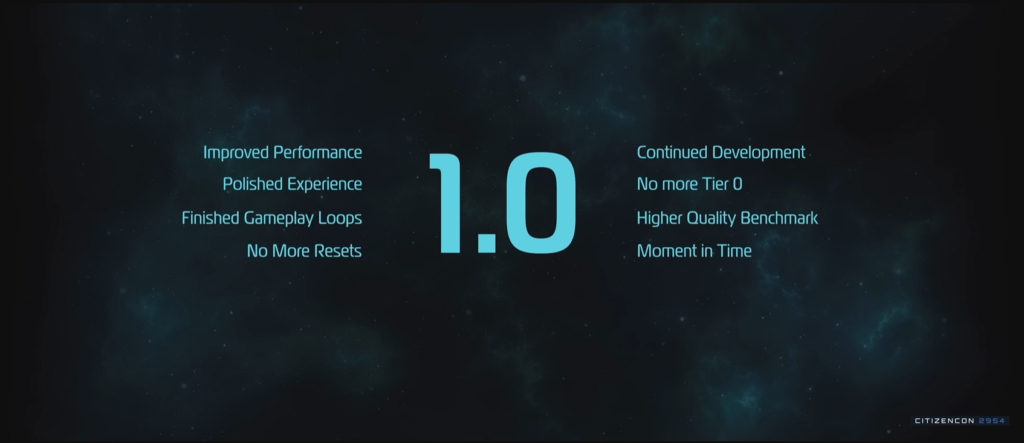
According to CIG, 1.0 will include the promises listed above.
- Improved performance. Server meshing is the next big technology that CIG claims will help improve the game’s performance, but there are other aspects which may or may not be part of this that will need to be done to boost server FPS and make the client more efficient on a wider range of gaming rigs.
- Polished Experience. Basically bug-hunting. Star Citizen has a massive amount of technical debt as we’re still experiencing issues that have existed for years, and more bugs seem to appear with each patch release than the patch itself addresses. CIG has never been good at dealing with this debt, preferring to focus on their “tier system” to introduce new systems with the promise of cleaning them up with later iterations.
- Finished Gameplay Loops. As mentioned in other posts, certain activities like mining and salvaging dead-end with sales being the only destination for harvested materials. These and other activities need to close their loops to ensure that missions exist as one-offs and chains, that our sandbox activities have meaning and value beyond the (a)UEC, and that systems interact with one another in meaningful ways that bring players together.
- No More Resets. After 1.0, progress will be retained between patches. This is kind of a no-brainer, but it’s nice to acknowledge.
- Continued Development. As with any live-service game, there’s always opportunities to add more content, fix more bugs, and enhance existing systems.
- No More Tier 0. New gameplay systems will be developed entirely behind the curtain of the public servers, meaning that they won’t (ideally) be released until they are fully formed, tested (internally and through the test universe servers), and approved.
- Higher Quality Benchmark. Playing into the previous point, no more “one step forward, two steps back” with each patch. I am most s
- Moment in Time. I don’t know what this really means, but it sounds like CIG is saying that if they promised it would be in the game, it might not make it in for 1.0, but it would make it in eventually. Yay, I guess?
What Kind of Game is Star Citizen
This has always been the elephant in the middle of the room, sitting on the couch and hogging all the snacks. It has been one of the most contentious points in the entire equation as the answer has always been either “PvP”, “PvE”, or “Both” depending on whether you are a PvE player, a PvP player who doesn’t get enough of their favorite gameplay opportunities, or CIG trying to thread a very difficult marketing needle. CIG claims that the game caters to PvPers, PvEers, and non-combatants equally, allowing everyone in the game to find gameplay they like and skip gameplay that they don’t. Even though these three seem mutually exclusive to supporters of one style over any other, CIG’s claim is that Star Citizen’s mandate isn’t to differentiate, but to ensure that all players can play together, regardless of religious affiliation.
100 Star Systems
If you have your ear to the ground you might have heard about this one.
When the Kickstarter launched, Star Citizen promised 100 star systems:
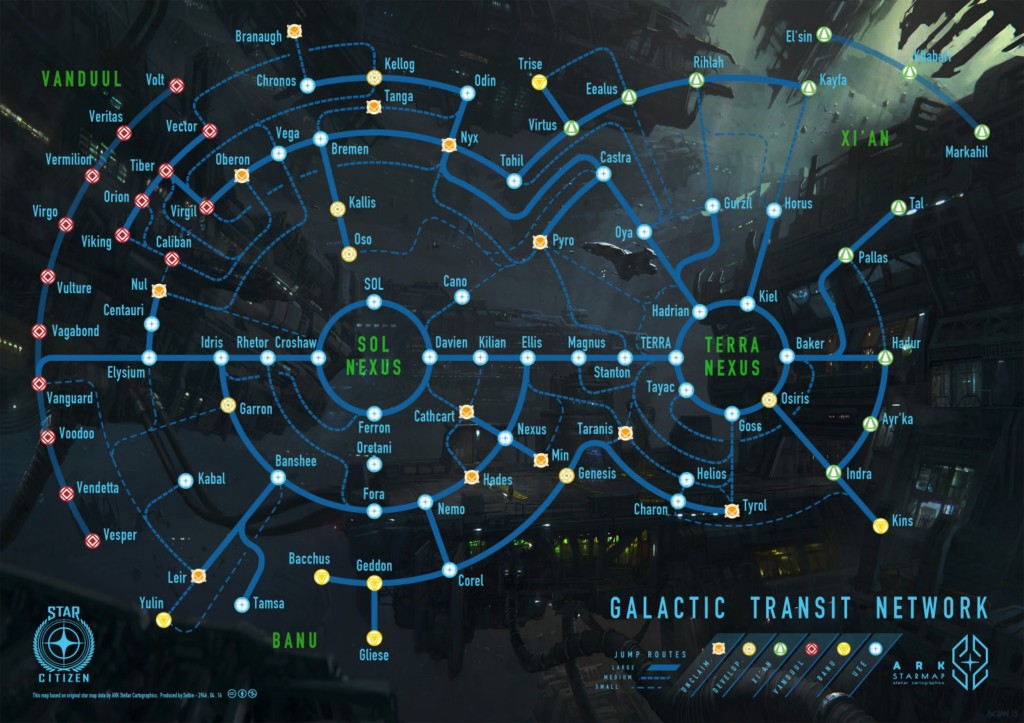
That was when the game was going to be like Freelancer: mainly menus, with generally indistinguishable solar systems. There were only going to be 90 points of interest in entire game. Now, though, with Star Citizen’s transformation into a first-person star simulation, getting 100 systems for a 1.0 launch is…not possible. Stanton alone currently has 1626 POI, and that number will grow exponentially when Starchitect enters the picture. It’s taken at least 2 years for Pyro to arrive, and while CIG has been working on tools like Genesis to speed the development of subsequent systems, it’s not going to be possible to release 1.0 with 100 systems.
Sandbox Citizen – Or Is It?
The presentation talked about what players will be able to experience in 1.0. We were assured that despite the sense that dropping from 100 systems to only as many as could be counted on one hand, the proposed targets that would exist within the systems we do get would be more numerous than we should be able to realistically handle.
Star Citizen is a complex game — I keep saying that because it’s important to understand — and mastering all aspects of gameplay on offer is going to be very difficult; not impossible, but difficult and expensive in terms of time and in-game cash. Learning the ins and outs of a “profession” is going to require study and practice, but first it’s going to require discovery. What options are there for new players? Hauling? Salvage? Medical? Bounty-hunting? Exploration? What is needed for any one of these, as the progression requires more than just “a specific class of ship”.
Main Story
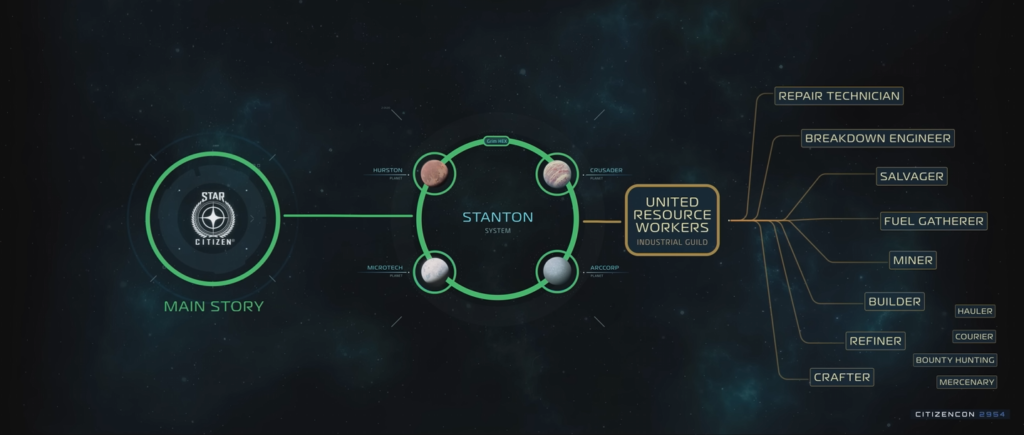
To that end, Star Citizen is getting a main story. It was spun as less a case of “sandboxes are scary” and more “a story can take the role of a tutorial and progression”, which makes sense. Although there’s lore in the game to weave disparate threads together for the discerning player, main and side stories in MMOs have been pretty good at pushing players through game systems for years now.
The only info we got on what this story would entail was that it would explore the tension between Earth and Terra — this becomes important later. It will be NPC driven, and is kind of optional. We can start it on day one, or we can put the story on hold to go out and do something completely different in the game.
Aside from learning the ropes of gameplay, locations, professions, and lore, what’s the point of playing through the main story especially for long-term backers who have had 10 years to learn the systems as they were introduced? Naturally there’ll be rewards, but there’s one reward prized above all others in the Star Citizen narrative universe, and that’s Citizenship.
What? You thought “Star Citizen” was some kind of generic code-name?
As a quick aside, the United Empire of Earth is organized like the ancient Roman Empire, complete with deposed Caesars and seditious states. Like in ancient Rome, the highest honor a regular person could achieve was citizenship which imparts certain rights and benefits that other “civilians” did not have. In Star Citizen, gaining citizenship could be achieved through service, military or otherwise. What gaining citizenship actually means, gameplay-wise, was not provided, but one hinted-at benefit centered on land ownership. Citizens will be able to purchase land anywhere in the UEE while civilians will have location and feature restrictions.
The story will span all 5 star systems available a launch and wil…wait…5 star systems? The previous presentations only said there were 4 star systems…
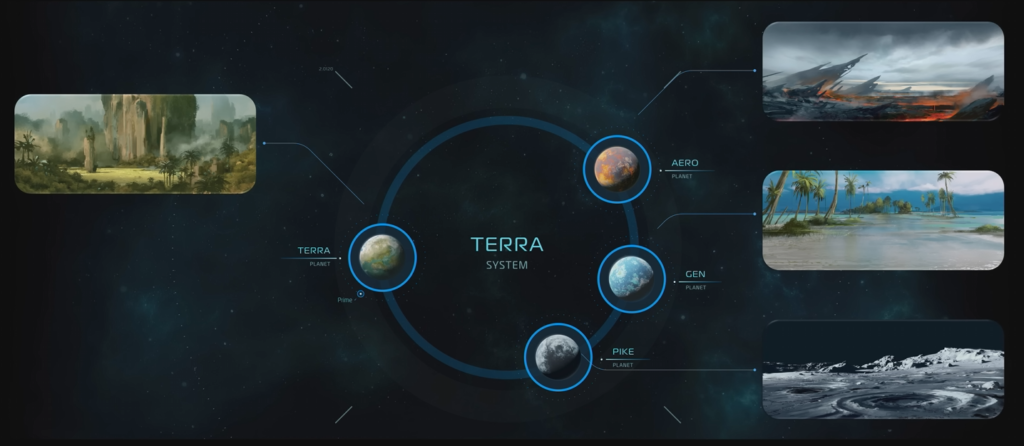
Meet Terra. This is a huge inclusion because Terra is central to the modern lore of the game universe. Terra is vying with ancient Earth in the Sol system for the soul of the UEE. It’s far more democratic-leaning than the imperialistic castes of Earth, and is home to some of the most beautiful planets in the Empire.
Location Stories
Basically, “side quests”. These can be had from points throughout the game universe and will be short and focused on local areas and NPC concerns.
For both the main story and in side-stories, CIG’s design goal will be to remove missions from the MOBIGlass Contract Manager and over to NPCs in a bid to make the mission system more organic and to get players to interact with NPCs. Some NPCs we’ll need to go talk to in person, and some we can communicate with through the MOBIGlass communications system, much like how we can now communicate with other players via VOIP built into the game.
Guilds
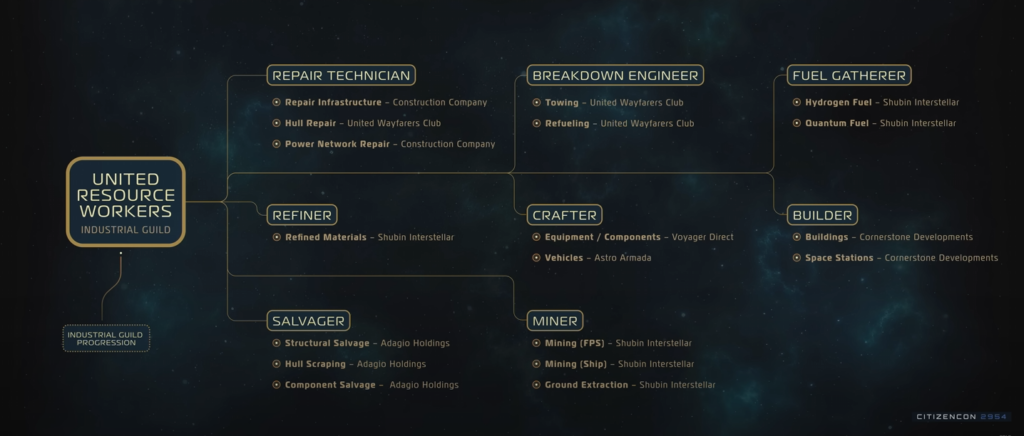
While the specifics of this main story weren’t explained, it was mentioned that the story will route players through the in-game guilds. Remember from a previous post that “guilds” are not “player organizations”, but represent umbrella groups that focus on more specific “factions”. These factions, in-turn, govern certain professional aspects. By aligning with a guild, a player can get the information they need through in-game story and missions to learn a profession that they are interested in. Players will earn rep with factions and their parent guilds, and this will act as a currency that allows access to more story, but also rewards like items and blueprints.
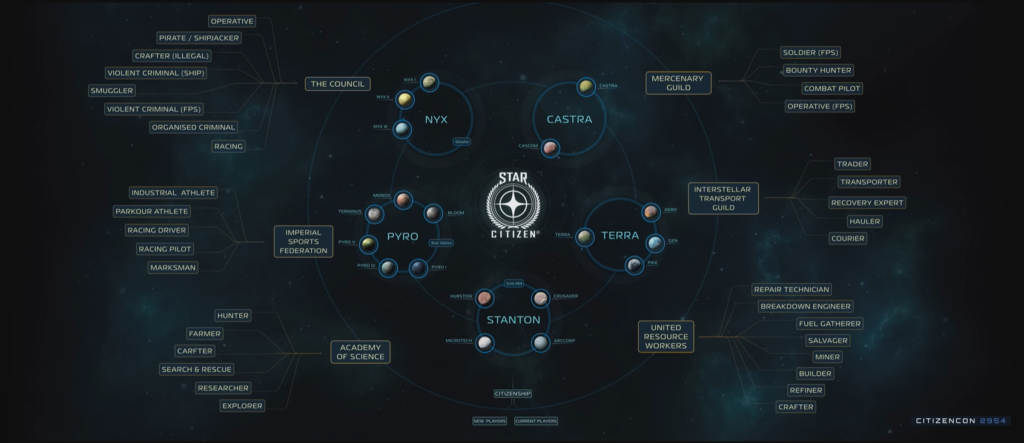
Economics
Aside from story and rep progression, there’s financial progression.
The StarSim system will still be in effect, although after watching so many videos and considering so many questions and half- to no-answers, I’m going to assume that the original plan of NPCs moving raw, refined, and finished materials around the universe is going to either be scaled back. During this presentation, it was said that StarSim would adjust prices in response to player activities. This shifts the burden of the game’s economy from a simulation to the players, at least to a point that will be noticiable by the players themselves. There will always need to be NPC vendors selling basic versions of everything, because everyone is a noob at one point, but it remains to be see whether it’s the NPCs or the players who have the greatest impact on the economy.
Following on the heels of that assumption, we can’t simply have money flowing in the direction of players as they craft and sell to one another. Players will need other money sinks to balance the economy lest we contribute to rampant inflation. One way that CIG plans to handle this is through taxes and insurance.
Death and Taxes
Way back in…2012? 2013? Chris Roberts penned an article on the RSI website which has become the cornerstone concept of Star Citizen, “Death of a Spaceman“. This lays out his vision for all kinds of things, specifically centered around his mantra of “risk versus reward”. It mainly focused on what happens when the risk overwhelms a player, and the aftermath. As no MMO that hopes to become profitable and popular would make permadeath their go-to mechanic, Roberts’ article outlined how death and resurrection would work in this early version of the game. It’s nothing super revolutionary as it relies on a version of “death and resurrection” concept that most video games have, but it adheres to the simulation nature of the game by suggesting that players are “regenerated” from DNA on file. Over time, however, that DNA degrades and eventually our characters will just…stop regenerating. At that point we’ll need to create a new character, but one that continues the legacy of the previous character through inheritance: inheritance of items, ships, some reputation, and money. Part of this in 1.0 will be the concept of an “inheritance tax” that is extracted as one character’s worldly possessions are passed on to the next generation. We didn’t get any specifics on how this will work in practice, so I’m sure CIG will use the time to have a long, deep think about it as something like this could light a powder-keg in the community if done incorrectly.
The other tax we’ve already mentioned, and that’s a tax on land ownership in UEE space. It was also not mentioned if this would be a flat tax on our plot, or a variable tax based on factors such as the number of buildings we have on our property.
Insurance
Medical insurance is going to be a thing, thank gawd — said no one. Currently, when we die we wake up in the medical facility we are bound to, at no cost to us. In the future, this is looking to change. Again, no specifics.
This brings us to ship insurance. Ship insurance as a concept has been on the books for quite some time. When making a pledge, there are often different insurance policies that are part of the pledge. Buying with store credit can net a variable amount of time such as 6 months, 10 months, 24 months, and so on. Warbond purchases — buying with new cash — and some concept ships pledged during special events like IAE can be bundled with “lifetime insurance” or LTI. Part of the meta-game is to pledge for low-cost items that have LTI, and then do a cross-chassis upgrade (CCU) to larger and more expensive ships over time; doing a CCU to a larger, more expensive ship carries the LTI forward, so it’s possible to get some pretty large ships with LTI at a cost lower than if they had been pledged for outright in one sitting.
Unfortunately, this topic sent the community into a tailspin, because insurance hasn’t been turned on in the game yet, and CIG’s explanation on how it would work in 1.0 was apparently unclear to many.
Loss of a ship should be a significant event. It was mentioned that over 90% of current insurance claims were for ships that were not destroyed — a fact no doubt buoyed by the fact that there are MANY bugs which can cause a ship to vanish, become inoperable, or blow up if you look at them wrong.
Here’s how it’s going to work. If you lose your ship, meaning you no longer have access to a complete working ship, there’ll be three levels of insurance payout:
- Chassis only.
- Chassis and Component.
- Chassis and Component and Decorations.
When insuring a ship, players can choose the level of compensation they want to receive; this will most certainly be a matter of front-door economics, as there’s no good reason to not get level 3 if one could afford it. Left alone, insurance will only reimburse the player in credits, and the amount of compensation will be a factor of the ship’s age and condition at the time of loss. Yes, an ancient beater Freelancer MAX will return less than a Freelancer MAX that blows up on its way out of the showroom. Term insurance will run out and we will be warned if we try to summon a ship without insurance.
On top of this, there’s the concept of warranty. If a player purchases insurance and has a warranty, they will receive a new ship rather than the credit value. Any pledge store ships will have a lifetime warranty and “appropriate” insurance. That means that no matter what happens, pledge store ships will always return a new ship — not just credits — when we lose them. What “appropriate” means in terms of tier of insurance, I’ll [refer you to this post]() penned by Jared Huckabee, Head Community Ninja, who spells out the situations. Short answer is that LTI means that we never have to manually renew our insurance, we will always have warranty. If we summon a ship which had term insurance and opt not to renew it, and lose the pledge store ship due to misadventure, we’ll have to pay an in-game fee but we’ll always get our ship back…we will never lose our pledge store ships so it might be just an inconvenience if we don’t renew our termed insurance before we fly.
Ships we purchase or craft in game will require a “transferrable warranty”. Warranties aren’t readily available at a point of sale like insurance is. We will have to “earn” them by doing things like completing the main story (Citizenship perk, no doubt). Once we have this warranty, we can move it between ships, although with a cooldown so we’re not just swapping every five minutes. I really do not know what the reason is behind splitting “insurance” and “warranties”, because it seems unnecessarily cumbersome especially when we’re talking about crafted ships. It’s nice that a player will get a full UEC payout if their crafted ship blows up with insurance, but what if that crafted ship was at tier 5? And what if an NPC-purchased ship was upgraded to tier 5? Is there a UEC value difference between the tiers, and if so, how can a player re-acquire a tier 5 ship with just a paycheck?
What about term insurance timers? If we buy or craft a ship, and buy insurance, the insurance period we can obtain is going to be based on the amount of time to craft that ship…not directly, as a 6 month insurance period shouldn’t need a 6 month construction lag-time. The period would be proportional, so a ship that takes 2x as long to build as another would have 2x the insurance…such as 12 months as opposed to 6. The reason behind this is that CIG wants to make lost ship retrieval more enticing than just shelling out money to get one delivered to your doorstep. If we do opt to claim a ship, smaller and starter ships will be delivered to us (if we have a warranty) near immediately, and larger and cap ships will take a significant amount of time.
Now, I can only imagine this comment is addressing the fact that many people — myself included — use insurance claims to instantly transport ships from one location to another (there’s issues with this set-up beyond insurance claims, really). To alleviate this aspect of “insurance fraud”, CIG will be offering courtesy shuttles that we can take from point A to point B if we are separated from a ship we own but which is elsewhere in the universe. This will be a free-of-charge shuttle rental, and when we’ve reached our destination, the shuttle will auto-pilot itself home and out of our inventories (no hot-wiring, sadly). Based on the statement in-video, though, this might also allow us to take a shuttle to a ship lost in space, like if we were pirated, killed, and our ship left in space. But I’m not sure about that.
Closing the Gameplay Loops
As an example, a player starting with a Prospector mining ship decides that they want a military grade F7 Hornet. Because they can’t just buy a military ship, they need to go on a journey to build one.
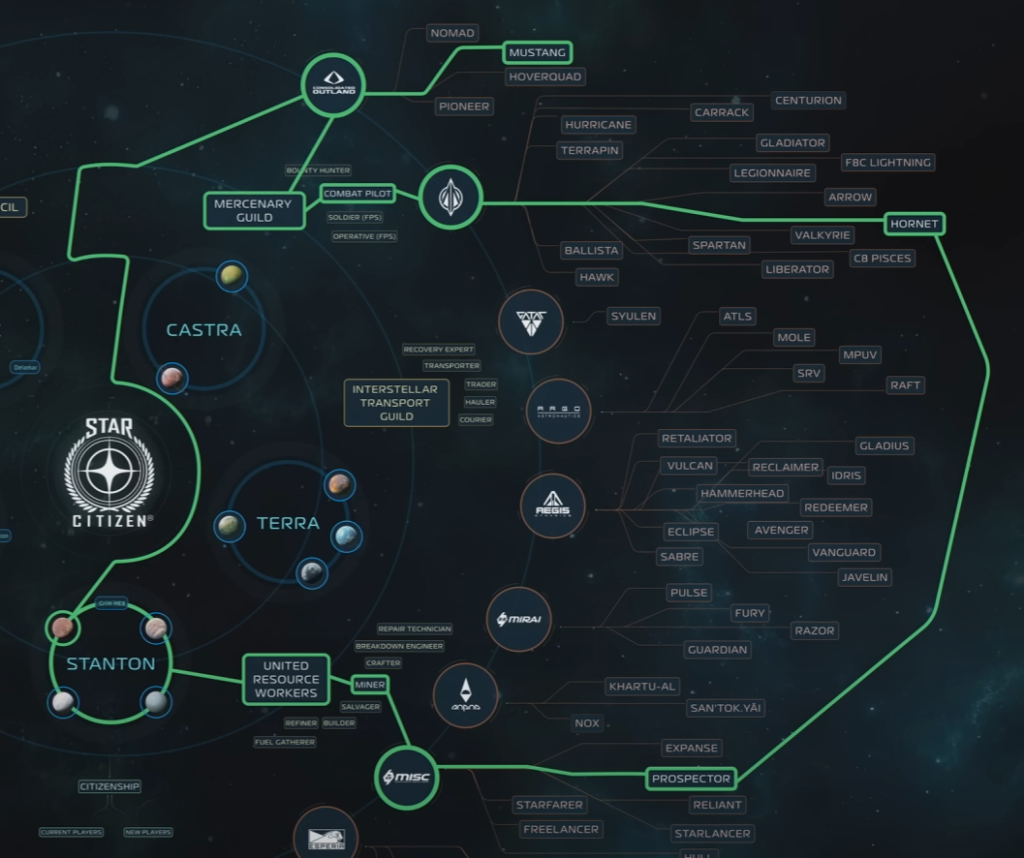
In this image, we start with the Prospector in the lower-right corner. The player would do some missions for the United Resource Workers mining resources in Stanton. After earning money, they buy a Mustang — a starter combat ship — and switch to taking missions from the Mercenary Guild. Eventually, they will earn enough rep to acquire the blueprint for the Hornet, but then they need to go back to the Prospector to harvest raw materials so they can use their new blueprint to build the Hornet.
By taking missions, earning rep, and filling in a few gaps with credits, this Prospector pilot can earn the blueprint and build the F7 Hornet. From there, other gameplay loops will open. Right now, we can only mine to sell resources. In 1.0, we can mine for credits, rep, resources, blueprints, and crafted items. While the end-goal is player determined, there will be steps involved that can be tackled through the main and side stories, and there will be times we get to dip out of those guided tours to do what we want or what we need.
The End Game
After finishing the story and tackling as many side-quests as we’re able, earning all the blueprints, buying, crafting, or stealing all the ships we want…what’s left?
CIG will always be adding new missions, group missions, and world events. There’s also going to be instanced content such as The Depths which sounds like it’s infinitively repeatable. One other example mentioned as “instanced content” was fleet battles which…we saw, but not in Star Citizen (and which I have yet to address). Despite my dislike of PvP content, I’d be up for this (although it might also be PvE content, they didn’t specify). StarSim will also be providing events such as spawning pirate fleets to intercept player-run resource shipments it detects. These are just some examples given.
What About PvP?
This was a significant portion of the presentation, so I’m going to recap it here as well, despite the fact that I dunno if I’ll ever get into this side of the game.
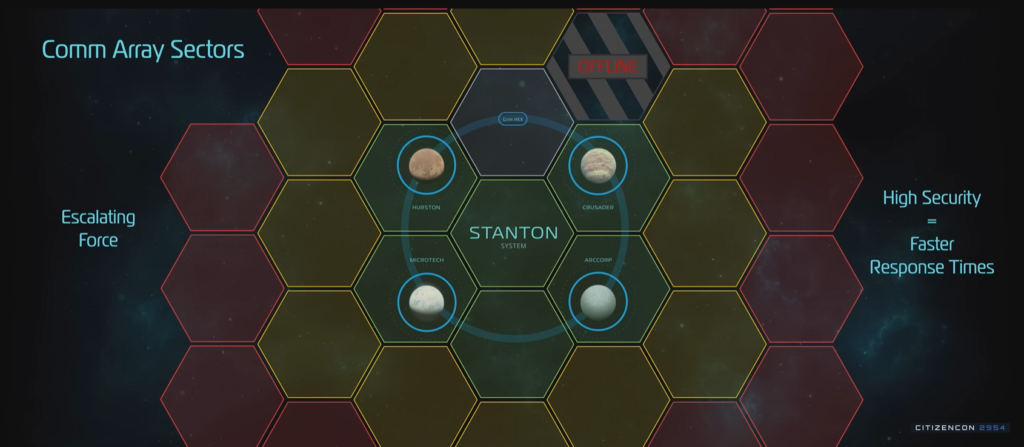
In lawful systems like Stanton, aggression will be monitored and the longer the engagement lasts, the more severe the lawful NPC response will be. Unlawful players can disable comm arrays to slow down this response, but doing so will generate a dynamic event to reactivate the comm array that other players can respond to.
But what about boarding and hijacking scenarios? We’ve looked at insurance, but not what happens when a player loses a ship to hijacking. If a ship is stolen, we can mark it as such which will disable the ship after a period of time. For the pirates, they have few options at that point: salvage it, tow it somewhere else, or if the pirates have a high enough rep, they can get the “dead-man’s switch” disabled and a new title issued, making the ship theirs. Of course, if this happens in a lawful system, the pirates will need to find a transient jump point to a lawless system as they won’t be able to use the main traffic conduits with a stolen ship.

For orgs (and wacky, unaffiliated players) who build bases in Pyro or Nyx, base raiding will be an option. To do this, base builders will need to fortify with walls, automated turrets, and localized shields. For attackers, they’ll need to fight their way in, disable the shields, and either bomb the place to hell or clear the zone to make stealing stuff easier.
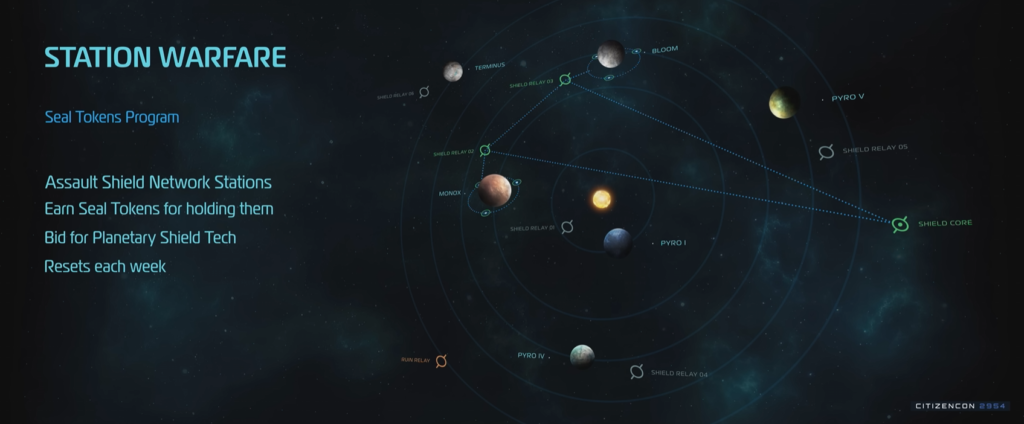
Another PvP option in lawless systems will be “station warfare”. Using a bit of lore handwaving, it was revealed that there used to be a network of maintained shield generators in Pyro, but because there was never enough to go around, only some mining towns got the shielding for a limited time. Who got it was based on a productivity “contest”, meaning that the shield benefits would move around on the regular. When the Pyro company pulled out of the system, they left the network in place. As a result, players will be able to fight on the ground and at the stations in the system for a chance to earn tokens that will power UEE-system-level base protection for a one-week period.
Org End Games
Station warfare can ensure that an org’s base in a lawless system is invulnerable for a week. Some folks on Spectrum are already pointing out exploitable situations and shortcomings of this system, but at the end of the day I think it’s a good idea for org warfare that keeps those kinds of orgs busy protecting their assets.
But this not the only end game for orgs.
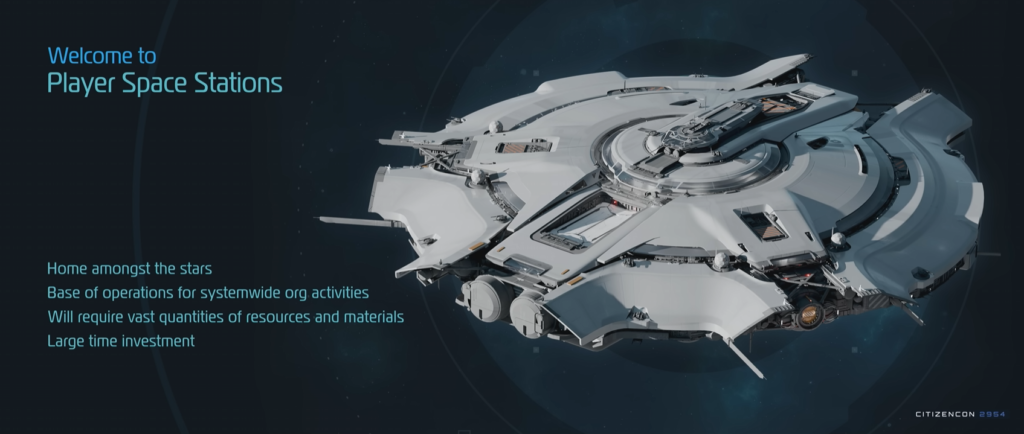
Org-owned space stations can be built using a Pioneer, and are designed to be an all-hands-on-deck, non violent end game for orgs. There’s a lot going on with these stations. They can include hangars, medical facilities, and even shops, just like NPC operated stations (or hopefully player operated ones as well). And they’re modular, allowing for additional facilities to be added when the basic internal facilities aren’t keeping up with traffic.
And for those times when your org has amassed a shit-ton of materials and need something to spend them on…
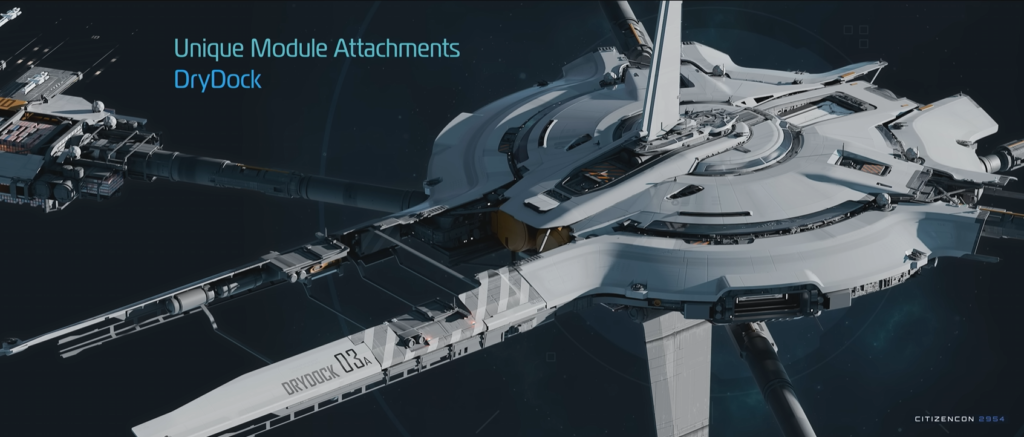
This is how powerful orgs can craft and repair their own capital ships.
![[Pasted image 20241024132013.png]]
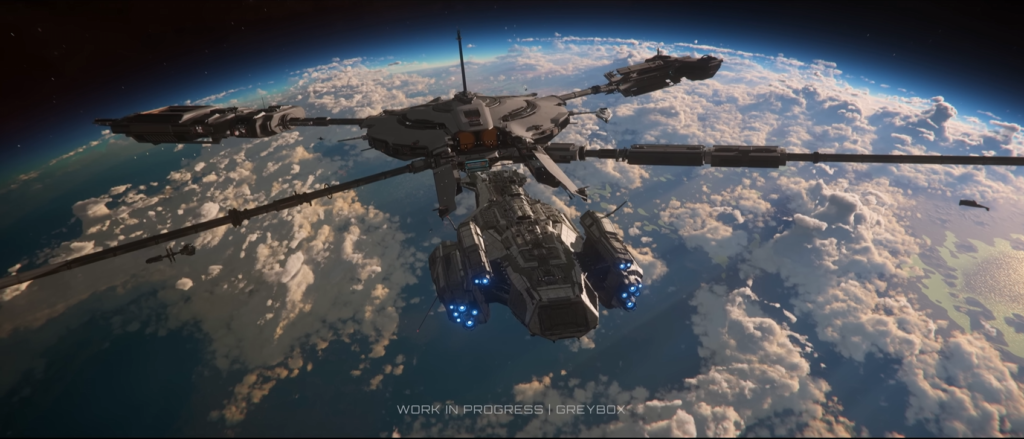
And one more thing….
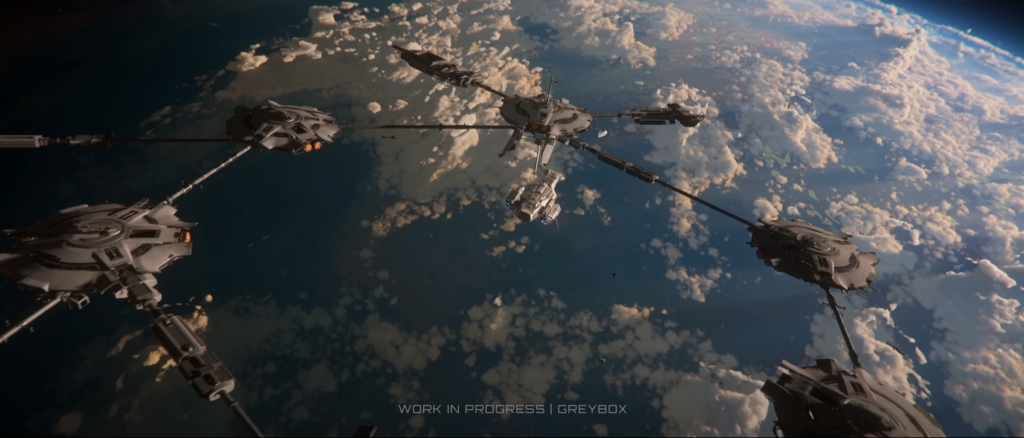
Multiple stations can be linked. While this results in something a stupidly powerful, “probably time to go play something else” sized org could do, it might also make sense for an alliance network to consolidate their presence in a particular system in order to share resources.
Thoughts
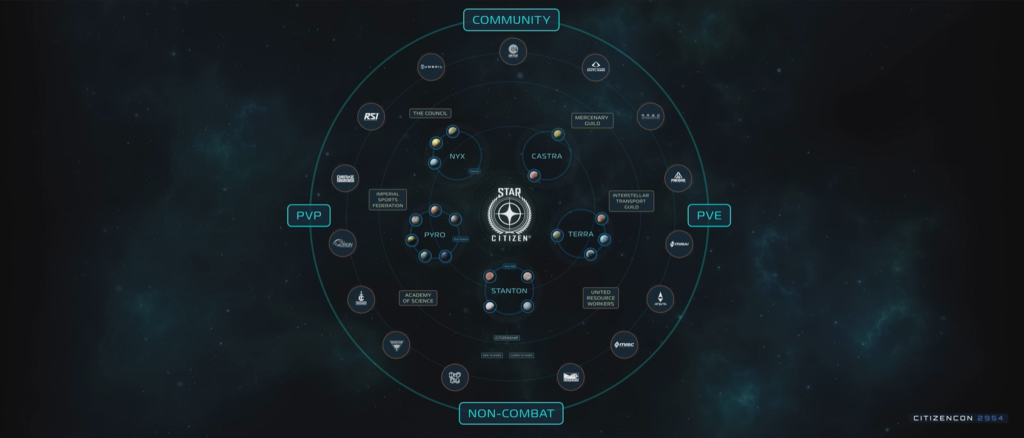
The concept of “1.0” is, quite honestly, a Hail Mary for CIG at this point. Star Citizen has always had its share of detractors, but I believe that its the growing dissatisfaction from within the community that is forcing CIG’s hand in setting a finish line for themselves. It also doesn’t help that we’ve seen more than a few articles discussing the company’s financial situation and alleged testimony from anonymous sources inside the company who complain about the culture and destructive workflows therein. I can’t say whether or not these articles are true, partially true, or fabrication but they certainly will bolster the confidence those outside the project who believe the game to be a “scam”, and are possibly serving to demoralize backers who are tired of CIG’s mounting tech debt, supposed tone-deafness in response to feedback, and inconsistent release cadence and quality. The drawing of a line in the sand with 1.0 might very well be CIG’s acceptance that it needs to be now or never.
As an OG backer and someone who plays regularly, there was a lot to like in this year’s CitizenCon presentations. I appreciate the Genesis world building tools because it sounds like they will help speed the production of planets, which are basically blobs of content, that can go a long way towards accelerating the path to 1.0. Crafting, of course, is a massive sell for me. I haven’t done any meaningful crafting profession in any MMO since Vanguard: Saga of Heroes. I loved Star Wars Galaxies crafting system, with it’s quality and experimentation mechanics, so I’m incredibly excited to have heard that CIG wants to make crafting more than the usual “have resource, push button” systems we get in MMOs. Base building is another great feature that appeals to me in part because I’m tired of the random HAB routine and would love to be able to settle in a secure system where I can store my stuff and not have to visit a landing zone unless there was a specific need to do so. Even the ideas behind org versus org “station warfare” — no doubt the remnants of the once-anticipated “Theaters of War” game mode — sounds like the kind of PvP that I have been known to enjoy, with groups of players taking on groups of players for territorial control.
Some things left me cool, though. The fact that the lawless Pyro system is the nexus for all travel (pre-Terra) does not make me happy because it makes Pyro unavoidable for any player who wants to leave their home system — even between Stanton and Castra. I’m also a little unclear on some of the features announced and how they will route players, like whether players will need to travel through a “contested zone” to reach the instanced “The Depths” zones, or if the main story is going to force players to spend more time in Pyro and Nyx than they otherwise would. Questions like these, born out of CIG’s own admission that players can experience the game the way that they want, lead me to believe that CIG really doesn’t have an interest in understanding how players play, or care to support playstyles that do not ascribe to their “risk versus rewards everywhere, all the time” ethos as the design of these systems supports the conclusion that all roads lead to PvP. The good news, though — as little as it is — is that when Terra comes online, players will be able to travel between there and Stanton directly.
This is CIG’s initial vision for Star Citizen. 5 solar systems, thousands of points of interest which can provide shopping, utilities, missions, PvE and PvP gameplay,, game loops, crafting, and player org activities. There’s a lot that wasn’t said, however, like anything about exploration gameplay, or how “Death of a Spaceman” would work (remember talk about cybernetic limbs? Will that still be a thing?). For everything we heard about in the road to 1.0, there were systems and features that were left out, meaning that however long we might think 1.0 will take, it will most certainly take a lot longer as CIG will need to address the things they didn’t address during this year’s convention.
What 1.0 means, though, is that CIG’s finally feeling the heat: from detractors, from those who are trying to make a name for themselves through controversy involving the company, and from it’s long-supporting, long-suffering community. I cannot see a case where CIG just up and decided that this 1.0 feature set was the goal all along. This panel just screamed of desperation, and while that’s not a good look, having a plan is something that I think Star Citizen has really lacked over these 10 years. It’s mainly been a collection of “great on paper” features, some or many of which have been made flesh, but the loose coupling of these ideas has allowed CIG to shape the collection in response to what seem to be the way the wind blows at any given time. So as weak or as incomplete as this road to 1.0 panel was in practice, I think that finally having a plan is good for the project in theory. Whether CIG can stick it will be another story entirely; I hope we’re not just transitioning into another protracted phase of the game’s production.
Make no mistake, though. I and many others can be both dissatisfied and hopeful, angry and exited, at the same time. I still want Star Citizen to reach a point where the workflow laid out in the first slide of the presentation becomes law. No more tier releases. Test and polish. The kinds of workflows that other game companies seem to do better than CIG has done. Even the feature set of 1.0 is pleasing to me, personally, as it sounds like there’ll be enough for me to do both solo, with friends, and with a player org. I look forward to discovering the implementation details of all of these systems, as I’m not one to cleave to my own head-canon where other people’s projects are concerned.




